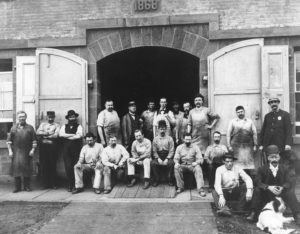HISTORIC SITE
Beginning in 1799, the present site of the National Lighthouse Museum on the North Shore of Staten Island, was the location of the New York Marine Hospital, also known as The Quarantine. Long before the construction of the famous processing center on Ellis Island, immigrants found to be in poor or questionable health were segregated from other immigrants, and the local population, in the hospital. The Quarantine was New York’s first line of defense against immigrant-borne infectious diseases like smallpox, cholera, typhus, and yellow fever. As many as 1,500 detainees could be accommodated in the hospital at one time.

Constructed on the former hospital site in 1862 by the United States Lighthouse Service (USLHS), the Staten Island Lighthouse Depot was the key manufacturing, storage, supply and maintenance center for the US Lighthouse Service’s 3rd District, and area which extended from Sandy Hook in the South, North to Albany and East to the Massachusetts border.
Growing steadily in both size and capability during the late 1800’s and early 1900’s the Staten Island Depot reached its peak size during and after the First World War.
Two shops were constructed to handle the construction and maintenance of Lighthouse and Lightship lenses, most of which weighed thousands of pounds and were several feet tall. Subterranean storage areas, called ‘The Vaults’ were built to store fuels and other combustible materials for lighthouses, and an entire machine shop and foundry where anchors, sinkers, chains, buoys, and lighthouse structural members were fabricated were all in full operation by the 1920’s.
Advancing technology saw many lighthouses automated during the 1920’s and 1930’s and replaced with more reliable electronic beacons, something which heavily altered the scope of the Depot’s mission as much of the upkeep, maintenance and lighthouse keeper supply work it performed was severely curtailed. This tail-off of work was checked by the massive increase in the use of Floating Aids-to-Navigation, or buoys. The Staten Island Depot’s foundry became one of the key manufacturing and maintenance point for many of the buoys used along the US East Coast, its quayside spaces became a forest of ocean buoys, channel markers, ice buoys, day-marks and their chains, anchors and sinkers.
With the US Lighthouse Service’s merger into the US Coast Guard in 1939, the Staten Island Depot continued its work, but during the Second World War it became more of a ship repair and outfitting space as many USCG Cutters, buoy tenders and harbor patrol craft called the Depot for wartime repainting, arming and voyage repairs. Following the war, the depot continued this work in addition to its maintenance and fabrication work and by 1950 it was one of the US Coast Guard’s major supply depots in the Northeast.
Advancing technology again caught up with the Depot by the 1960’s as all lighthouses had been automated with low-maintenance beacons, only two lightships were in service and the amount of Buoy Tenders in USCG service began to drop as each ship became more operationally capable. Budget cuts and consolidation in the late 1960’s saw much of the Staten Island Depot’s workload sent to the USCG Yard at Curtis Bay, MD and by 1965 the Staten Island Depot was closed. Following a period of inactivity, the land was formally donated by the US Coast Guard to the City of New York in 1978, and several of the pier side buildings were razed to make room for a Staten Island Ferry maintenance facility, which utilized the former depot’s piers.
Today, Building 11 has been renovated and is now the home of the National Lighthouse Museum Educational Resource Center. Several of the original buildings including the lamp shops, barracks and administration building still stand onsite, but need major renovation. The present owner of the site, the New York City Economic Development Corporation has contracted for the development of the entire land tract. Plans for the Lighthouse Point development project include residential and commercial space with renovation and reuse of several of the site’s historic structures. The National Lighthouse Museum, the cultural component of the site development, plans to expand into Building 10 within the next five years.




